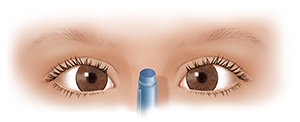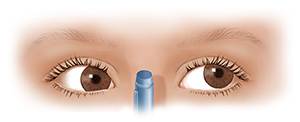Convergence Insufficiency (Child)
Convergence insufficiency (CI) is a problem with the way the eye moves, or the way the eyes move together. It makes it hard to focus on things up close. When the eyes converge, it means they point inward (toward the midline) to focus on something close. With CI, the eyes have trouble doing this. One eye may turn out instead of looking inward. CI can cause blurred vision, double vision, and eye strain. Your child may need to close one eye when reading. CI may cause a child to have problems in school. Your child may be a slow reader because they have trouble focusing. These problems may go away once CI is treated.
How normal vision works
With normal vision, the eyes work together to form one image. When your child looks from an object that’s far away to one that’s close, the lens inside the eye changes its shape. The hole that lets light into the eye (pupil) becomes smaller. And the eyes move slightly inward (converge). The eye and brain work together to make all of these changes. The result is a single, focused image. When reading, the eyes and brain also have to do quick, complex eye movements to look across and down a page.
 |
| Normal vision. |
 |
| Convergence insufficiency. |
What causes convergence insufficiency?
Researchers are not yet sure what causes CI. There may be problems in the complex actions that the brain and eyes do. This may be because of genes. CI tends to run in families. In some cases, a health condition can contribute to CI, such as:
Symptoms of convergence insufficiency
Your child is most likely to have symptoms of CI when doing work close-up, such as reading or writing. Symptoms are more likely if they are reading or writing for a long period of time. Fatigue also can bring on symptoms. Symptoms can include:
-
Headache,
-
Double vision
-
Eye fatigue
-
Blurred vision
-
Sleepiness when reading
-
Needing to reread things several times
-
Trouble concentrating on what they are reading
-
Losing their place in the text when reading
-
Squinting while reading
You may also notice that one of your child’s eyes sometimes turns outward as they read. This may cause blurred vision. Or you may notice your child squinting or closing one of their eyes while reading. This can make it easier to see a single, focused image. Symptoms tend to get worse during the teens and 20s. They are often steady after that.
Diagnosing convergence insufficiency
The eye care provider will ask about your child’s past health. They will give your child an eye exam. This will include testing for visual sharpness. They will also test how your child’s eyes converge. This is done while your child looks closely at something. Your child may do this test with each eye separately, and then together.
Treatment for convergence insufficiency
CI is most often treated with special exercises. Your child will be shown how to do these exercises. They may need to do them regularly at home. Some of these exercises are done while looking through prisms. If your child does the exercises regularly, their symptoms may go away in a fairly short period of time. Computer programs can also help treat CI. These can make the eyes better able to converge. They can also measure how the eyes are getting better over time.
Covering one eye may ease symptoms for a short time, but it doesn't help correct CI. It also doesn't give your child practice working with both eyes together, which is important to correct CI. Your child may need to cover one eye for a short time if they have a lot of reading to do. But keep in mind that it’s not a long-term solution.
In some cases, the symptoms of CI don't go away with treatment. Your child’s eye care provider may prescribe special prism glasses for reading. These can help your child read more comfortably. In very rare cases, an eye care provider may advise surgery.
Helping your child at home
Exercises to treat CI work well for most children. But to work well they need to be done regularly. You can help your child by making sure they do the exercises as often as directed by the eye care provider. Vision problems can be very frustrating and discouraging to a child, especially when they interfere with the child's schoolwork. You can help your child by explaining the condition in an age-appropriate manner and providing the emotional support and encouragement they need to do the exercises.